Business Environment: Competitive Policy and Legislative Framework
VerifiedAdded on 2023/06/16
|9
|2602
|181
Report
AI Summary
This report provides a comprehensive analysis of the business environment, focusing on various aspects relevant to organisations like Marks and Spencer. It begins by explaining different types of business organisations across sectors, including public, private, and voluntary sectors, highlighting their characteristics and examples. The report then delves into various legal structures such as sole proprietorship, partnership, corporation, and limited liability company, outlining their advantages and disadvantages. A clear distinction between public and private ownership is provided, emphasizing differences in objectives, regulations, and funding sources. Further, the report explains the United Kingdom's competitive policy and legislative framework, including the roles of the Competition and Markets Authority in reviewing business practices. It also discusses the objectives and instruments of fiscal and monetary policies used by the government to regulate the economy during a recession. Finally, the report defines globalisation and its impacts on business, competition, and the economy, noting both the potential benefits and challenges for companies operating in a globalized market. Desklib offers a variety of solved assignments and past papers for students.
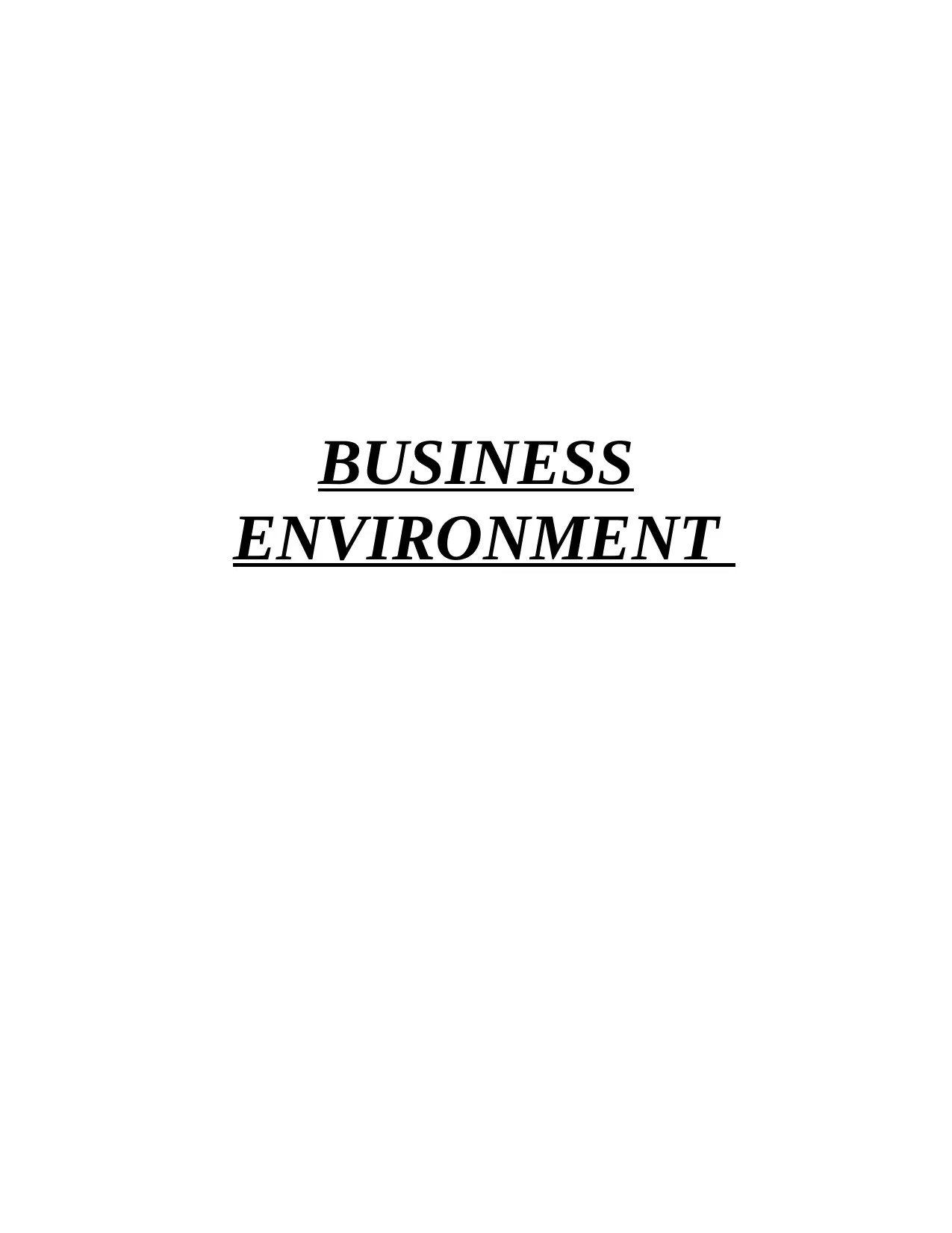
BUSINESS
ENVIRONMENT
ENVIRONMENT
Paraphrase This Document
Need a fresh take? Get an instant paraphrase of this document with our AI Paraphraser
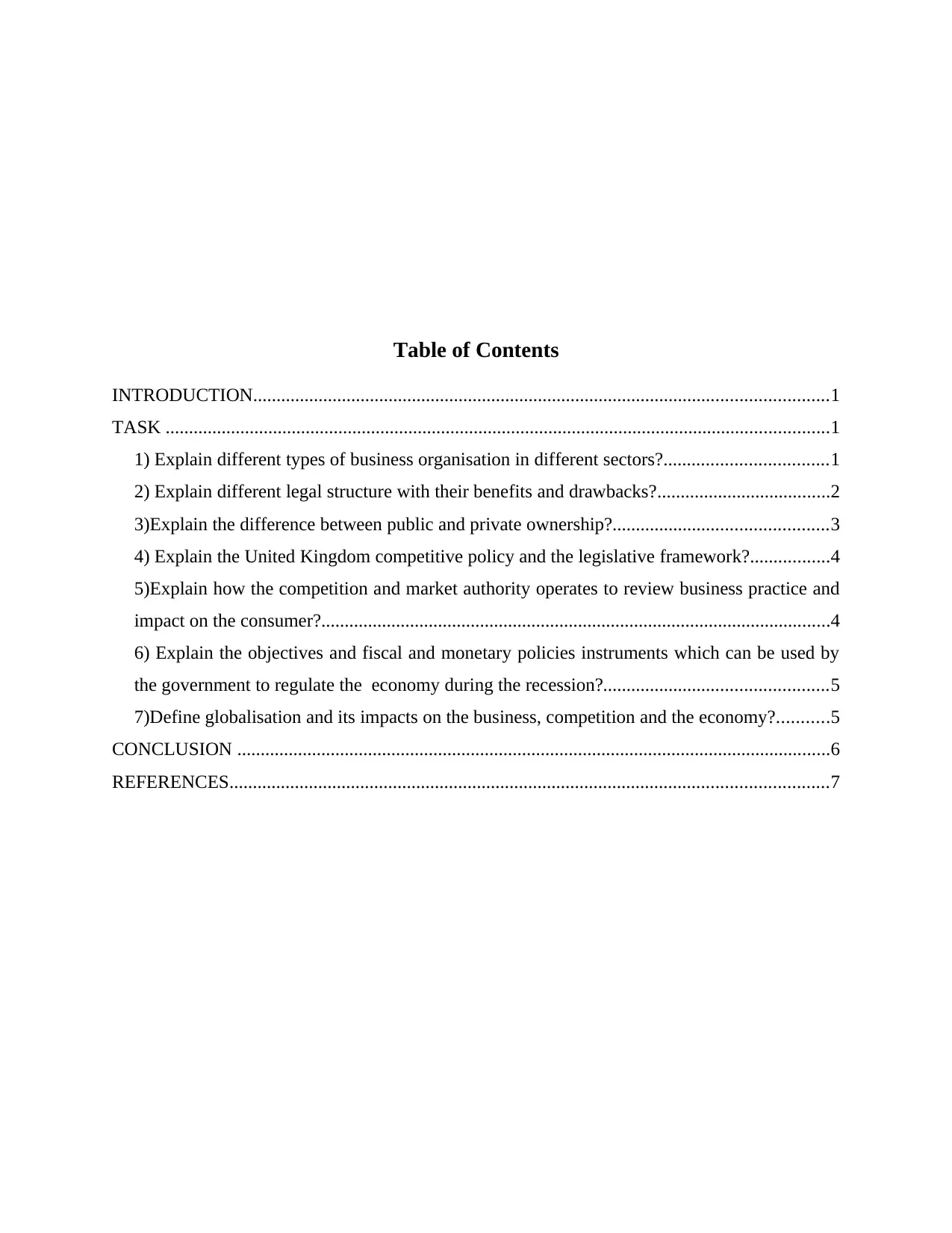
Table of Contents
INTRODUCTION...........................................................................................................................1
TASK ..............................................................................................................................................1
1) Explain different types of business organisation in different sectors?...................................1
2) Explain different legal structure with their benefits and drawbacks?.....................................2
3)Explain the difference between public and private ownership?..............................................3
4) Explain the United Kingdom competitive policy and the legislative framework?.................4
5)Explain how the competition and market authority operates to review business practice and
impact on the consumer?.............................................................................................................4
6) Explain the objectives and fiscal and monetary policies instruments which can be used by
the government to regulate the economy during the recession?................................................5
7)Define globalisation and its impacts on the business, competition and the economy?...........5
CONCLUSION ...............................................................................................................................6
REFERENCES................................................................................................................................7
INTRODUCTION...........................................................................................................................1
TASK ..............................................................................................................................................1
1) Explain different types of business organisation in different sectors?...................................1
2) Explain different legal structure with their benefits and drawbacks?.....................................2
3)Explain the difference between public and private ownership?..............................................3
4) Explain the United Kingdom competitive policy and the legislative framework?.................4
5)Explain how the competition and market authority operates to review business practice and
impact on the consumer?.............................................................................................................4
6) Explain the objectives and fiscal and monetary policies instruments which can be used by
the government to regulate the economy during the recession?................................................5
7)Define globalisation and its impacts on the business, competition and the economy?...........5
CONCLUSION ...............................................................................................................................6
REFERENCES................................................................................................................................7
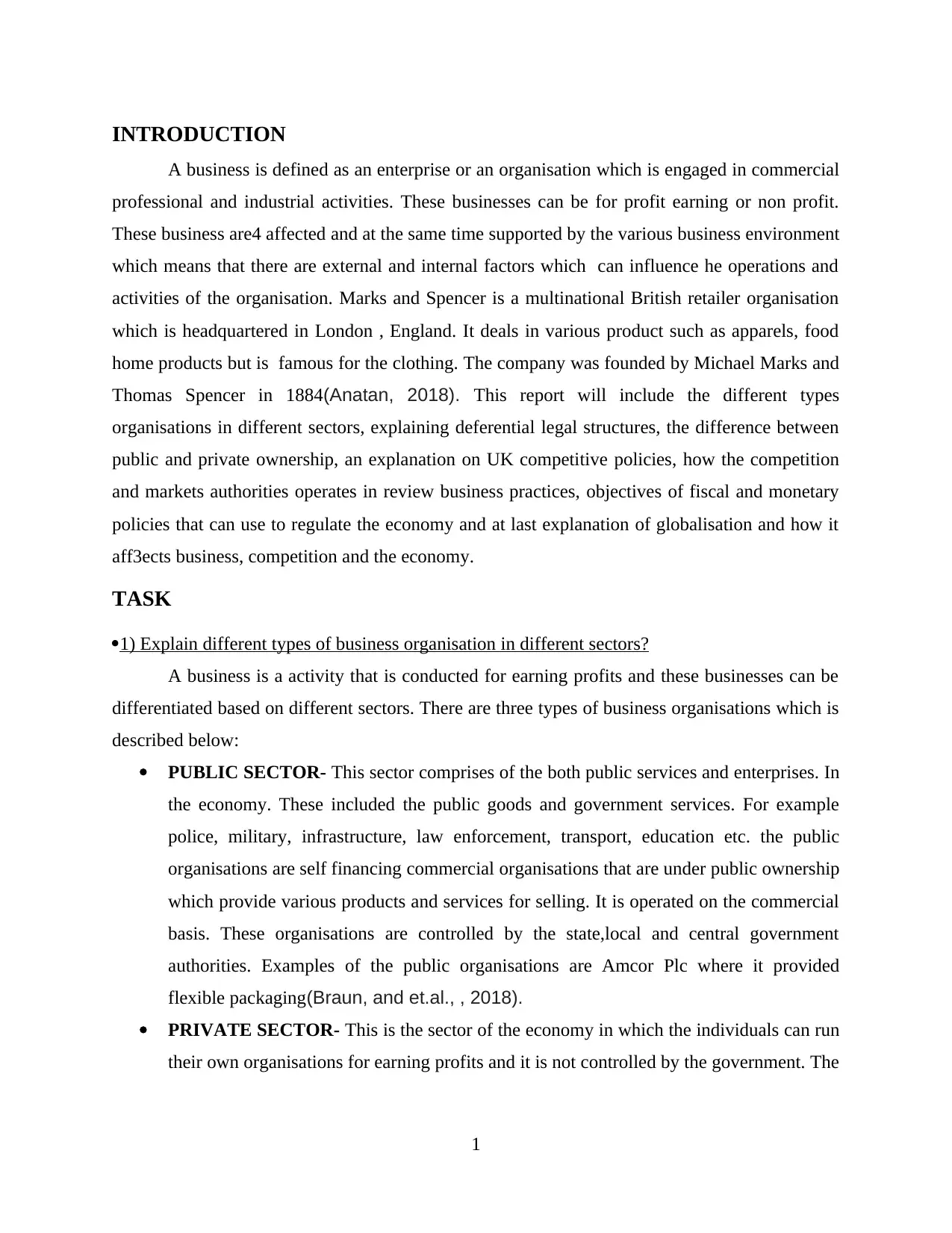
INTRODUCTION
A business is defined as an enterprise or an organisation which is engaged in commercial
professional and industrial activities. These businesses can be for profit earning or non profit.
These business are4 affected and at the same time supported by the various business environment
which means that there are external and internal factors which can influence he operations and
activities of the organisation. Marks and Spencer is a multinational British retailer organisation
which is headquartered in London , England. It deals in various product such as apparels, food
home products but is famous for the clothing. The company was founded by Michael Marks and
Thomas Spencer in 1884(Anatan, 2018). This report will include the different types
organisations in different sectors, explaining deferential legal structures, the difference between
public and private ownership, an explanation on UK competitive policies, how the competition
and markets authorities operates in review business practices, objectives of fiscal and monetary
policies that can use to regulate the economy and at last explanation of globalisation and how it
aff3ects business, competition and the economy.
TASK
1) Explain different types of business organisation in different sectors?
A business is a activity that is conducted for earning profits and these businesses can be
differentiated based on different sectors. There are three types of business organisations which is
described below:
PUBLIC SECTOR- This sector comprises of the both public services and enterprises. In
the economy. These included the public goods and government services. For example
police, military, infrastructure, law enforcement, transport, education etc. the public
organisations are self financing commercial organisations that are under public ownership
which provide various products and services for selling. It is operated on the commercial
basis. These organisations are controlled by the state,local and central government
authorities. Examples of the public organisations are Amcor Plc where it provided
flexible packaging(Braun, and et.al., , 2018).
PRIVATE SECTOR- This is the sector of the economy in which the individuals can run
their own organisations for earning profits and it is not controlled by the government. The
1
A business is defined as an enterprise or an organisation which is engaged in commercial
professional and industrial activities. These businesses can be for profit earning or non profit.
These business are4 affected and at the same time supported by the various business environment
which means that there are external and internal factors which can influence he operations and
activities of the organisation. Marks and Spencer is a multinational British retailer organisation
which is headquartered in London , England. It deals in various product such as apparels, food
home products but is famous for the clothing. The company was founded by Michael Marks and
Thomas Spencer in 1884(Anatan, 2018). This report will include the different types
organisations in different sectors, explaining deferential legal structures, the difference between
public and private ownership, an explanation on UK competitive policies, how the competition
and markets authorities operates in review business practices, objectives of fiscal and monetary
policies that can use to regulate the economy and at last explanation of globalisation and how it
aff3ects business, competition and the economy.
TASK
1) Explain different types of business organisation in different sectors?
A business is a activity that is conducted for earning profits and these businesses can be
differentiated based on different sectors. There are three types of business organisations which is
described below:
PUBLIC SECTOR- This sector comprises of the both public services and enterprises. In
the economy. These included the public goods and government services. For example
police, military, infrastructure, law enforcement, transport, education etc. the public
organisations are self financing commercial organisations that are under public ownership
which provide various products and services for selling. It is operated on the commercial
basis. These organisations are controlled by the state,local and central government
authorities. Examples of the public organisations are Amcor Plc where it provided
flexible packaging(Braun, and et.al., , 2018).
PRIVATE SECTOR- This is the sector of the economy in which the individuals can run
their own organisations for earning profits and it is not controlled by the government. The
1
⊘ This is a preview!⊘
Do you want full access?
Subscribe today to unlock all pages.

Trusted by 1+ million students worldwide
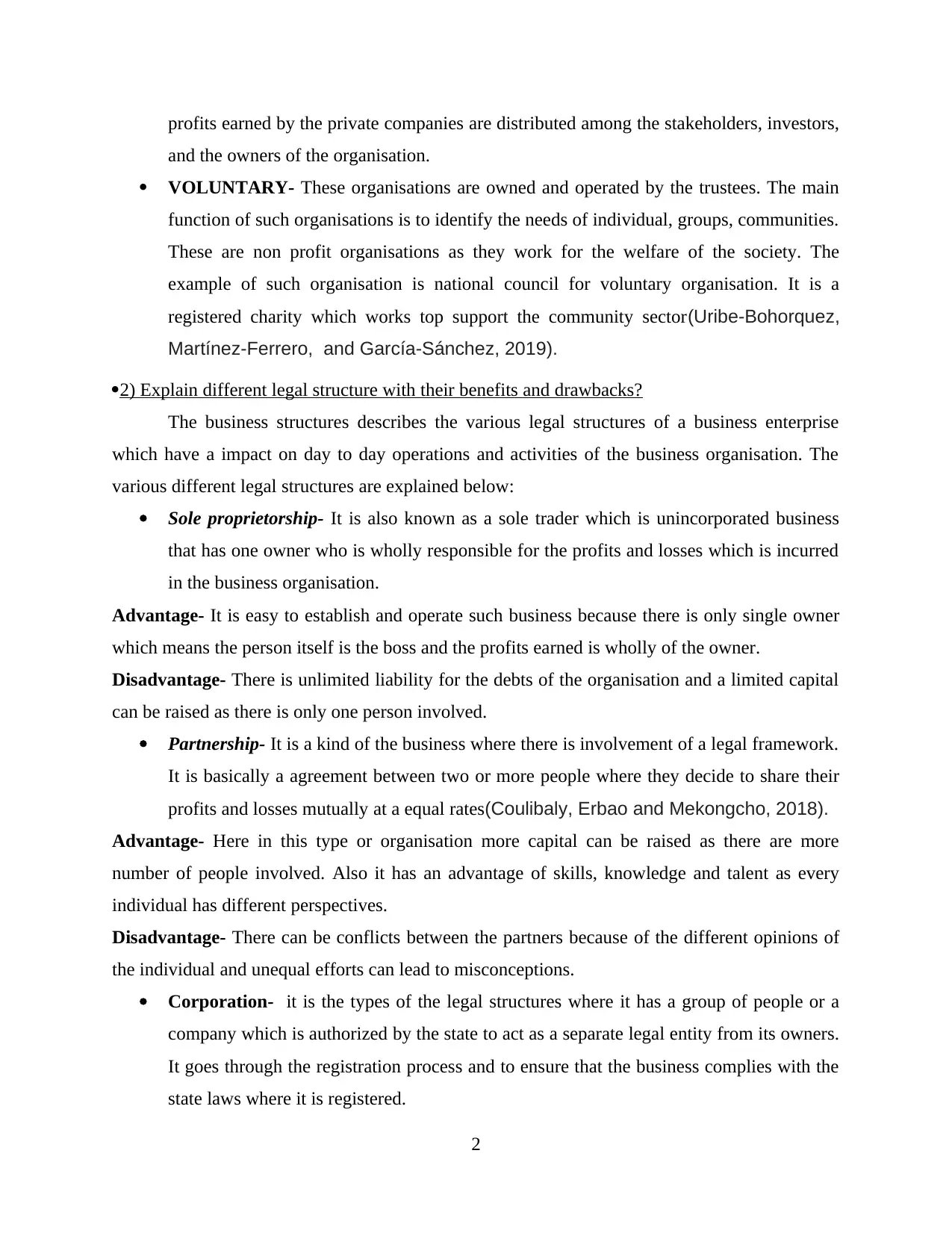
profits earned by the private companies are distributed among the stakeholders, investors,
and the owners of the organisation.
VOLUNTARY- These organisations are owned and operated by the trustees. The main
function of such organisations is to identify the needs of individual, groups, communities.
These are non profit organisations as they work for the welfare of the society. The
example of such organisation is national council for voluntary organisation. It is a
registered charity which works top support the community sector(Uribe‐Bohorquez,
Martínez‐Ferrero, and García‐Sánchez, 2019).
2) Explain different legal structure with their benefits and drawbacks?
The business structures describes the various legal structures of a business enterprise
which have a impact on day to day operations and activities of the business organisation. The
various different legal structures are explained below:
Sole proprietorship- It is also known as a sole trader which is unincorporated business
that has one owner who is wholly responsible for the profits and losses which is incurred
in the business organisation.
Advantage- It is easy to establish and operate such business because there is only single owner
which means the person itself is the boss and the profits earned is wholly of the owner.
Disadvantage- There is unlimited liability for the debts of the organisation and a limited capital
can be raised as there is only one person involved.
Partnership- It is a kind of the business where there is involvement of a legal framework.
It is basically a agreement between two or more people where they decide to share their
profits and losses mutually at a equal rates(Coulibaly, Erbao and Mekongcho, 2018).
Advantage- Here in this type or organisation more capital can be raised as there are more
number of people involved. Also it has an advantage of skills, knowledge and talent as every
individual has different perspectives.
Disadvantage- There can be conflicts between the partners because of the different opinions of
the individual and unequal efforts can lead to misconceptions.
Corporation- it is the types of the legal structures where it has a group of people or a
company which is authorized by the state to act as a separate legal entity from its owners.
It goes through the registration process and to ensure that the business complies with the
state laws where it is registered.
2
and the owners of the organisation.
VOLUNTARY- These organisations are owned and operated by the trustees. The main
function of such organisations is to identify the needs of individual, groups, communities.
These are non profit organisations as they work for the welfare of the society. The
example of such organisation is national council for voluntary organisation. It is a
registered charity which works top support the community sector(Uribe‐Bohorquez,
Martínez‐Ferrero, and García‐Sánchez, 2019).
2) Explain different legal structure with their benefits and drawbacks?
The business structures describes the various legal structures of a business enterprise
which have a impact on day to day operations and activities of the business organisation. The
various different legal structures are explained below:
Sole proprietorship- It is also known as a sole trader which is unincorporated business
that has one owner who is wholly responsible for the profits and losses which is incurred
in the business organisation.
Advantage- It is easy to establish and operate such business because there is only single owner
which means the person itself is the boss and the profits earned is wholly of the owner.
Disadvantage- There is unlimited liability for the debts of the organisation and a limited capital
can be raised as there is only one person involved.
Partnership- It is a kind of the business where there is involvement of a legal framework.
It is basically a agreement between two or more people where they decide to share their
profits and losses mutually at a equal rates(Coulibaly, Erbao and Mekongcho, 2018).
Advantage- Here in this type or organisation more capital can be raised as there are more
number of people involved. Also it has an advantage of skills, knowledge and talent as every
individual has different perspectives.
Disadvantage- There can be conflicts between the partners because of the different opinions of
the individual and unequal efforts can lead to misconceptions.
Corporation- it is the types of the legal structures where it has a group of people or a
company which is authorized by the state to act as a separate legal entity from its owners.
It goes through the registration process and to ensure that the business complies with the
state laws where it is registered.
2
Paraphrase This Document
Need a fresh take? Get an instant paraphrase of this document with our AI Paraphraser
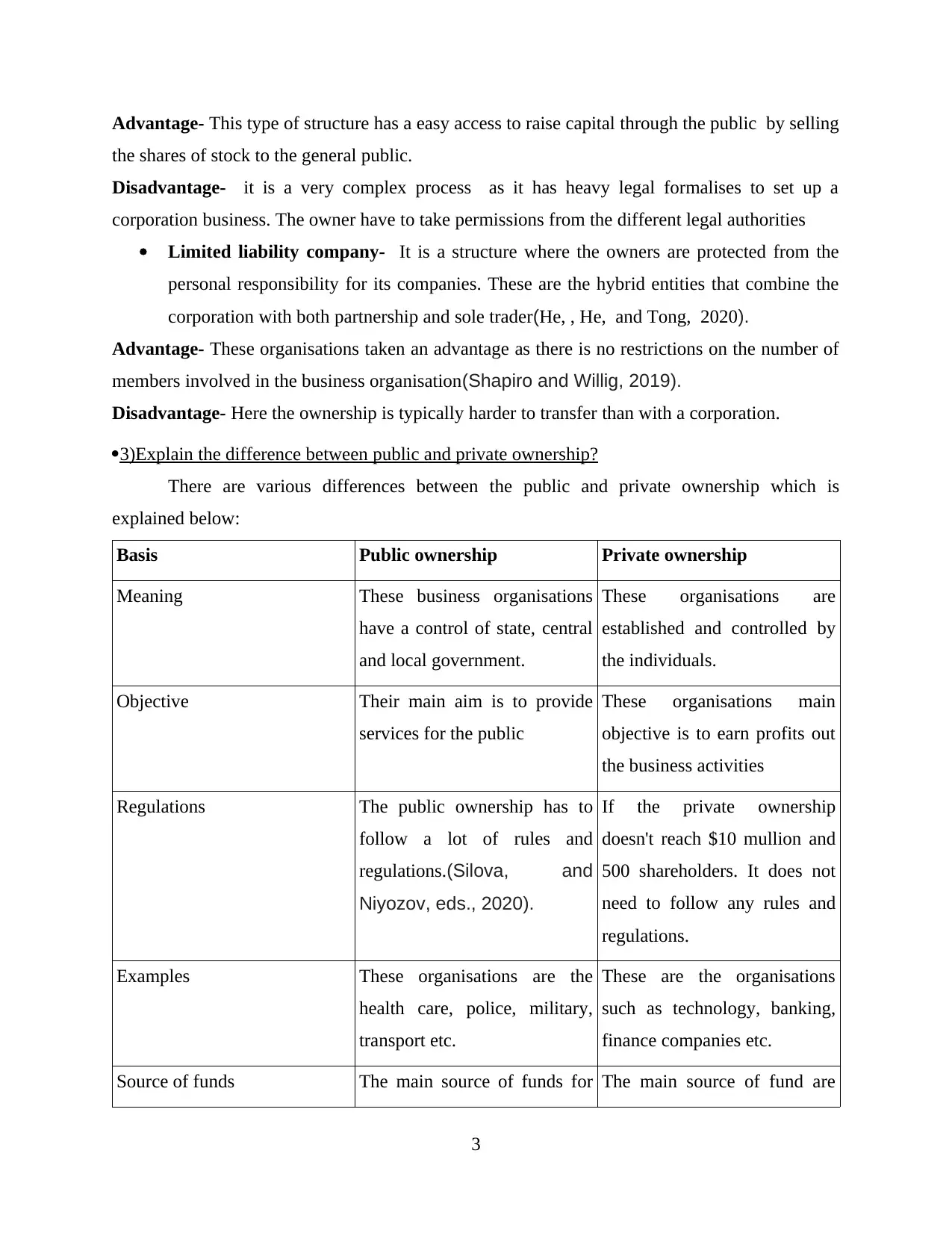
Advantage- This type of structure has a easy access to raise capital through the public by selling
the shares of stock to the general public.
Disadvantage- it is a very complex process as it has heavy legal formalises to set up a
corporation business. The owner have to take permissions from the different legal authorities
Limited liability company- It is a structure where the owners are protected from the
personal responsibility for its companies. These are the hybrid entities that combine the
corporation with both partnership and sole trader(He, , He, and Tong, 2020).
Advantage- These organisations taken an advantage as there is no restrictions on the number of
members involved in the business organisation(Shapiro and Willig, 2019).
Disadvantage- Here the ownership is typically harder to transfer than with a corporation.
3)Explain the difference between public and private ownership?
There are various differences between the public and private ownership which is
explained below:
Basis Public ownership Private ownership
Meaning These business organisations
have a control of state, central
and local government.
These organisations are
established and controlled by
the individuals.
Objective Their main aim is to provide
services for the public
These organisations main
objective is to earn profits out
the business activities
Regulations The public ownership has to
follow a lot of rules and
regulations.(Silova, and
Niyozov, eds., 2020).
If the private ownership
doesn't reach $10 mullion and
500 shareholders. It does not
need to follow any rules and
regulations.
Examples These organisations are the
health care, police, military,
transport etc.
These are the organisations
such as technology, banking,
finance companies etc.
Source of funds The main source of funds for The main source of fund are
3
the shares of stock to the general public.
Disadvantage- it is a very complex process as it has heavy legal formalises to set up a
corporation business. The owner have to take permissions from the different legal authorities
Limited liability company- It is a structure where the owners are protected from the
personal responsibility for its companies. These are the hybrid entities that combine the
corporation with both partnership and sole trader(He, , He, and Tong, 2020).
Advantage- These organisations taken an advantage as there is no restrictions on the number of
members involved in the business organisation(Shapiro and Willig, 2019).
Disadvantage- Here the ownership is typically harder to transfer than with a corporation.
3)Explain the difference between public and private ownership?
There are various differences between the public and private ownership which is
explained below:
Basis Public ownership Private ownership
Meaning These business organisations
have a control of state, central
and local government.
These organisations are
established and controlled by
the individuals.
Objective Their main aim is to provide
services for the public
These organisations main
objective is to earn profits out
the business activities
Regulations The public ownership has to
follow a lot of rules and
regulations.(Silova, and
Niyozov, eds., 2020).
If the private ownership
doesn't reach $10 mullion and
500 shareholders. It does not
need to follow any rules and
regulations.
Examples These organisations are the
health care, police, military,
transport etc.
These are the organisations
such as technology, banking,
finance companies etc.
Source of funds The main source of funds for The main source of fund are
3
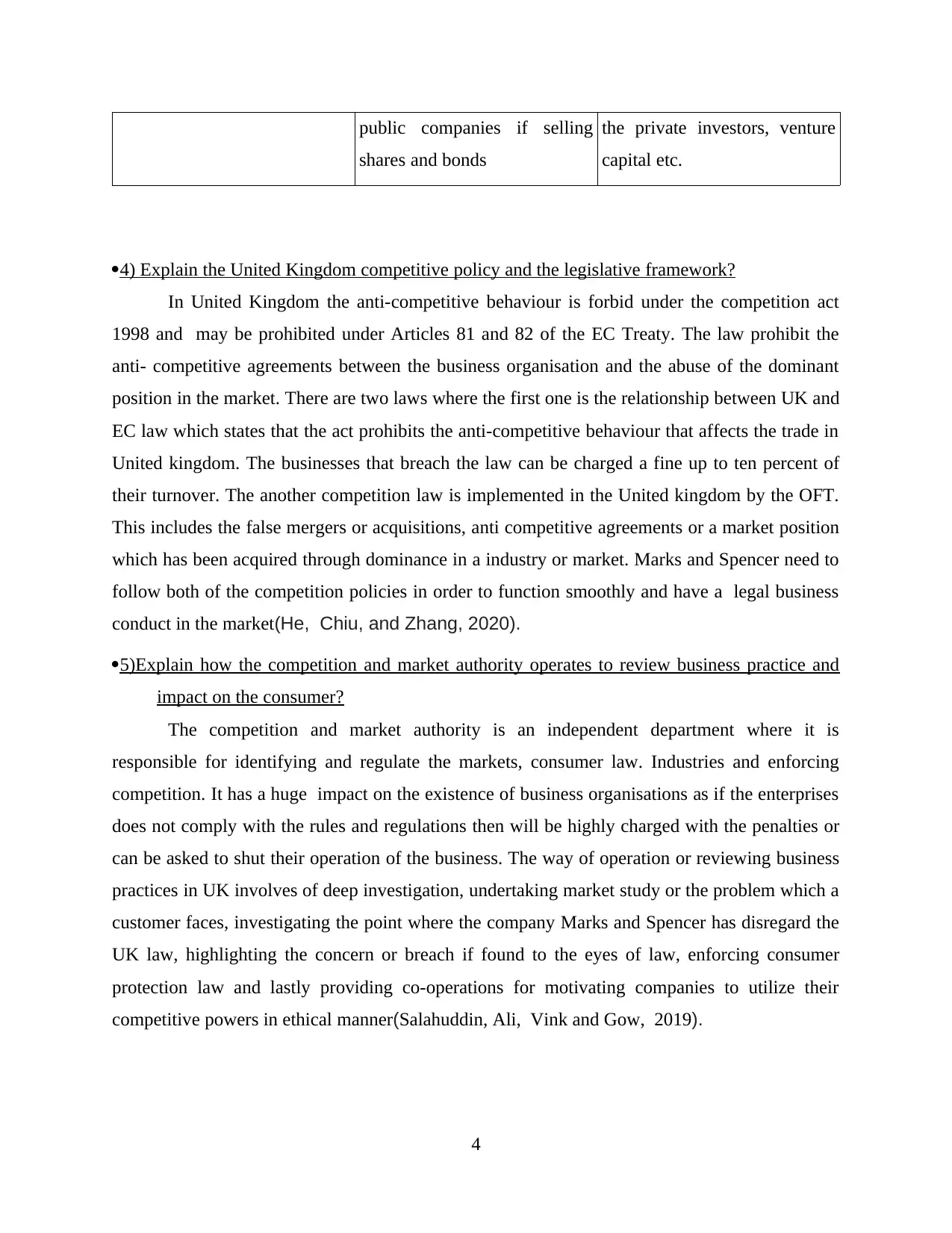
public companies if selling
shares and bonds
the private investors, venture
capital etc.
4) Explain the United Kingdom competitive policy and the legislative framework?
In United Kingdom the anti-competitive behaviour is forbid under the competition act
1998 and may be prohibited under Articles 81 and 82 of the EC Treaty. The law prohibit the
anti- competitive agreements between the business organisation and the abuse of the dominant
position in the market. There are two laws where the first one is the relationship between UK and
EC law which states that the act prohibits the anti-competitive behaviour that affects the trade in
United kingdom. The businesses that breach the law can be charged a fine up to ten percent of
their turnover. The another competition law is implemented in the United kingdom by the OFT.
This includes the false mergers or acquisitions, anti competitive agreements or a market position
which has been acquired through dominance in a industry or market. Marks and Spencer need to
follow both of the competition policies in order to function smoothly and have a legal business
conduct in the market(He, Chiu, and Zhang, 2020).
5)Explain how the competition and market authority operates to review business practice and
impact on the consumer?
The competition and market authority is an independent department where it is
responsible for identifying and regulate the markets, consumer law. Industries and enforcing
competition. It has a huge impact on the existence of business organisations as if the enterprises
does not comply with the rules and regulations then will be highly charged with the penalties or
can be asked to shut their operation of the business. The way of operation or reviewing business
practices in UK involves of deep investigation, undertaking market study or the problem which a
customer faces, investigating the point where the company Marks and Spencer has disregard the
UK law, highlighting the concern or breach if found to the eyes of law, enforcing consumer
protection law and lastly providing co-operations for motivating companies to utilize their
competitive powers in ethical manner(Salahuddin, Ali, Vink and Gow, 2019).
4
shares and bonds
the private investors, venture
capital etc.
4) Explain the United Kingdom competitive policy and the legislative framework?
In United Kingdom the anti-competitive behaviour is forbid under the competition act
1998 and may be prohibited under Articles 81 and 82 of the EC Treaty. The law prohibit the
anti- competitive agreements between the business organisation and the abuse of the dominant
position in the market. There are two laws where the first one is the relationship between UK and
EC law which states that the act prohibits the anti-competitive behaviour that affects the trade in
United kingdom. The businesses that breach the law can be charged a fine up to ten percent of
their turnover. The another competition law is implemented in the United kingdom by the OFT.
This includes the false mergers or acquisitions, anti competitive agreements or a market position
which has been acquired through dominance in a industry or market. Marks and Spencer need to
follow both of the competition policies in order to function smoothly and have a legal business
conduct in the market(He, Chiu, and Zhang, 2020).
5)Explain how the competition and market authority operates to review business practice and
impact on the consumer?
The competition and market authority is an independent department where it is
responsible for identifying and regulate the markets, consumer law. Industries and enforcing
competition. It has a huge impact on the existence of business organisations as if the enterprises
does not comply with the rules and regulations then will be highly charged with the penalties or
can be asked to shut their operation of the business. The way of operation or reviewing business
practices in UK involves of deep investigation, undertaking market study or the problem which a
customer faces, investigating the point where the company Marks and Spencer has disregard the
UK law, highlighting the concern or breach if found to the eyes of law, enforcing consumer
protection law and lastly providing co-operations for motivating companies to utilize their
competitive powers in ethical manner(Salahuddin, Ali, Vink and Gow, 2019).
4
⊘ This is a preview!⊘
Do you want full access?
Subscribe today to unlock all pages.

Trusted by 1+ million students worldwide
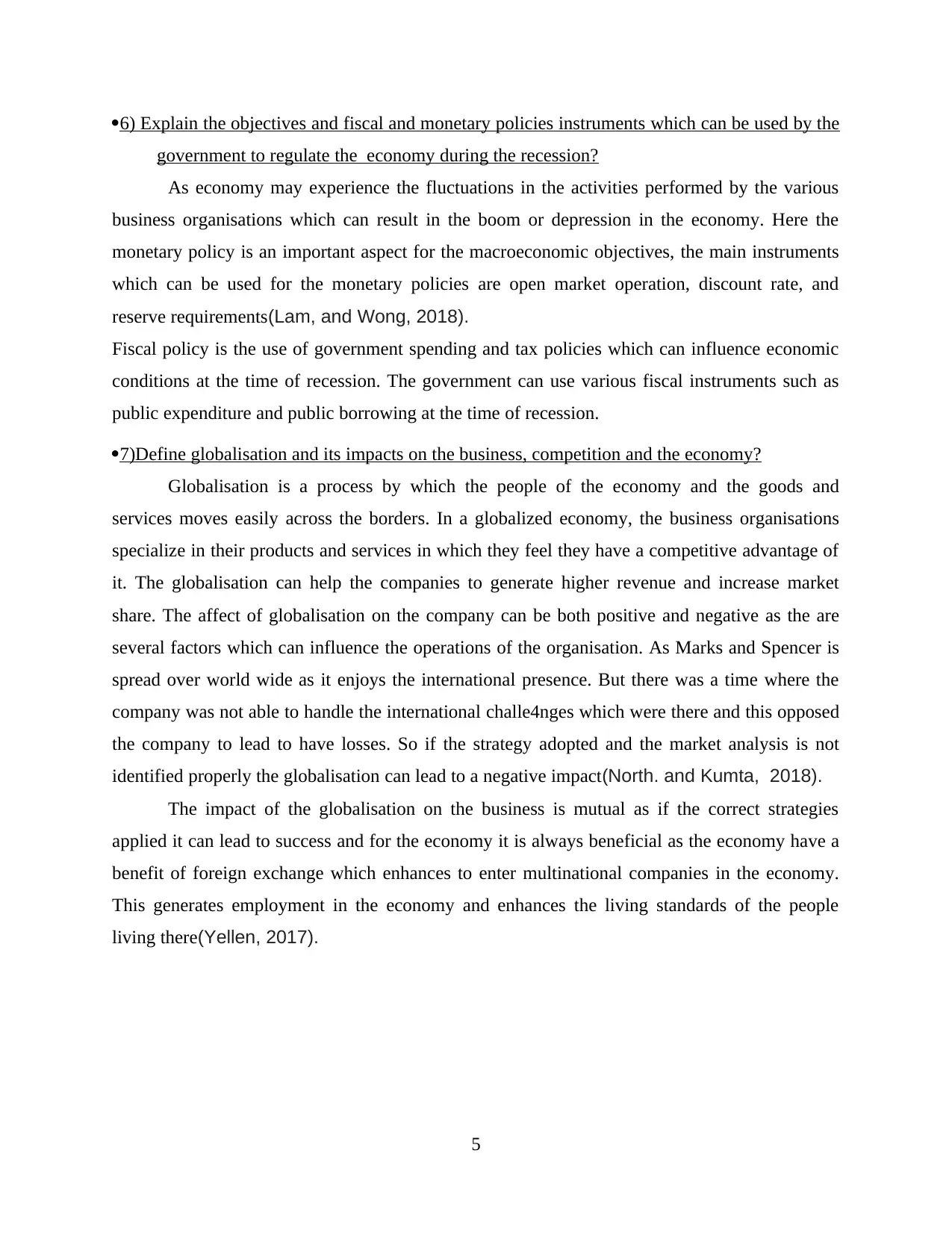
6) Explain the objectives and fiscal and monetary policies instruments which can be used by the
government to regulate the economy during the recession?
As economy may experience the fluctuations in the activities performed by the various
business organisations which can result in the boom or depression in the economy. Here the
monetary policy is an important aspect for the macroeconomic objectives, the main instruments
which can be used for the monetary policies are open market operation, discount rate, and
reserve requirements(Lam, and Wong, 2018).
Fiscal policy is the use of government spending and tax policies which can influence economic
conditions at the time of recession. The government can use various fiscal instruments such as
public expenditure and public borrowing at the time of recession.
7)Define globalisation and its impacts on the business, competition and the economy?
Globalisation is a process by which the people of the economy and the goods and
services moves easily across the borders. In a globalized economy, the business organisations
specialize in their products and services in which they feel they have a competitive advantage of
it. The globalisation can help the companies to generate higher revenue and increase market
share. The affect of globalisation on the company can be both positive and negative as the are
several factors which can influence the operations of the organisation. As Marks and Spencer is
spread over world wide as it enjoys the international presence. But there was a time where the
company was not able to handle the international challe4nges which were there and this opposed
the company to lead to have losses. So if the strategy adopted and the market analysis is not
identified properly the globalisation can lead to a negative impact(North. and Kumta, 2018).
The impact of the globalisation on the business is mutual as if the correct strategies
applied it can lead to success and for the economy it is always beneficial as the economy have a
benefit of foreign exchange which enhances to enter multinational companies in the economy.
This generates employment in the economy and enhances the living standards of the people
living there(Yellen, 2017).
5
government to regulate the economy during the recession?
As economy may experience the fluctuations in the activities performed by the various
business organisations which can result in the boom or depression in the economy. Here the
monetary policy is an important aspect for the macroeconomic objectives, the main instruments
which can be used for the monetary policies are open market operation, discount rate, and
reserve requirements(Lam, and Wong, 2018).
Fiscal policy is the use of government spending and tax policies which can influence economic
conditions at the time of recession. The government can use various fiscal instruments such as
public expenditure and public borrowing at the time of recession.
7)Define globalisation and its impacts on the business, competition and the economy?
Globalisation is a process by which the people of the economy and the goods and
services moves easily across the borders. In a globalized economy, the business organisations
specialize in their products and services in which they feel they have a competitive advantage of
it. The globalisation can help the companies to generate higher revenue and increase market
share. The affect of globalisation on the company can be both positive and negative as the are
several factors which can influence the operations of the organisation. As Marks and Spencer is
spread over world wide as it enjoys the international presence. But there was a time where the
company was not able to handle the international challe4nges which were there and this opposed
the company to lead to have losses. So if the strategy adopted and the market analysis is not
identified properly the globalisation can lead to a negative impact(North. and Kumta, 2018).
The impact of the globalisation on the business is mutual as if the correct strategies
applied it can lead to success and for the economy it is always beneficial as the economy have a
benefit of foreign exchange which enhances to enter multinational companies in the economy.
This generates employment in the economy and enhances the living standards of the people
living there(Yellen, 2017).
5
Paraphrase This Document
Need a fresh take? Get an instant paraphrase of this document with our AI Paraphraser
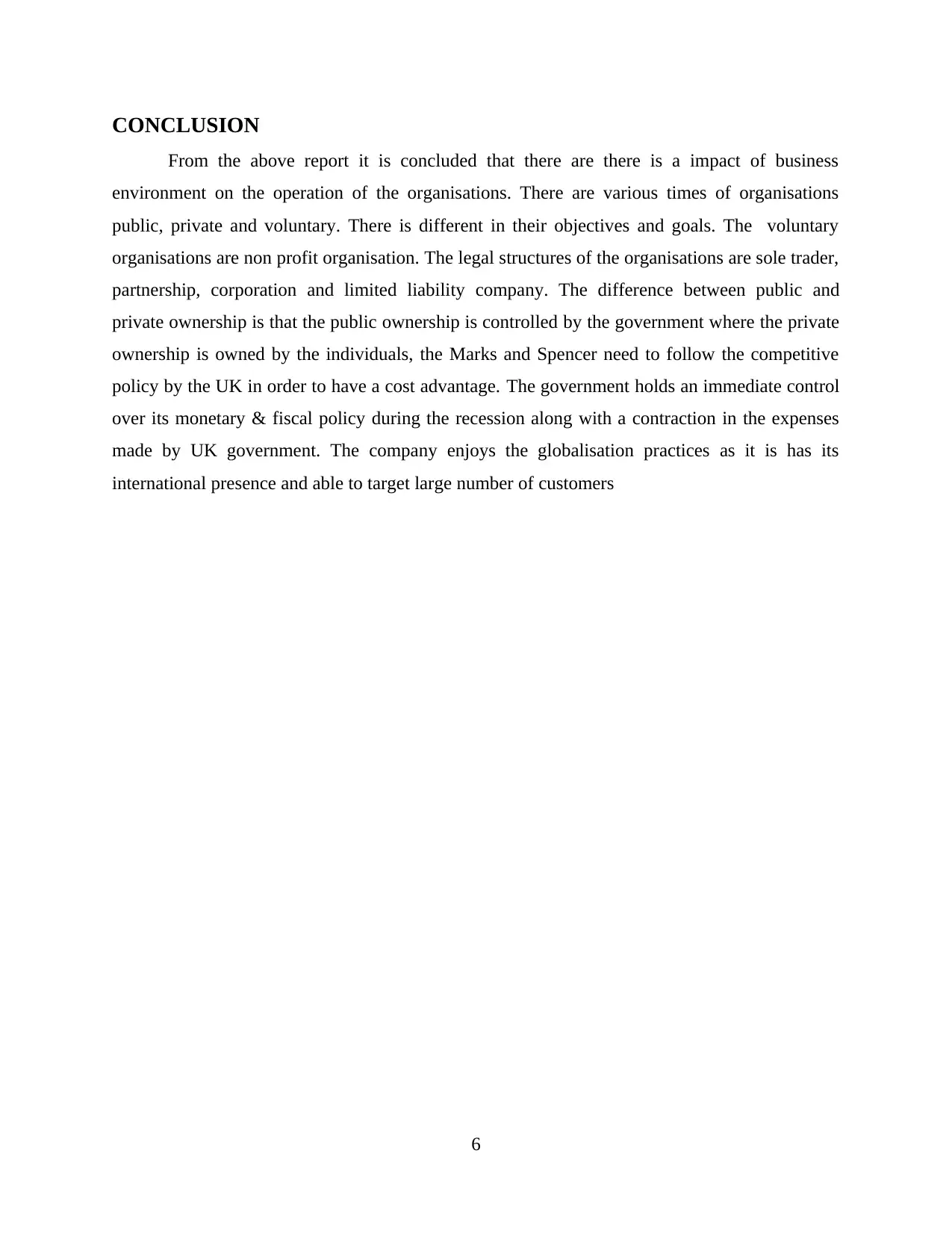
CONCLUSION
From the above report it is concluded that there are there is a impact of business
environment on the operation of the organisations. There are various times of organisations
public, private and voluntary. There is different in their objectives and goals. The voluntary
organisations are non profit organisation. The legal structures of the organisations are sole trader,
partnership, corporation and limited liability company. The difference between public and
private ownership is that the public ownership is controlled by the government where the private
ownership is owned by the individuals, the Marks and Spencer need to follow the competitive
policy by the UK in order to have a cost advantage. The government holds an immediate control
over its monetary & fiscal policy during the recession along with a contraction in the expenses
made by UK government. The company enjoys the globalisation practices as it is has its
international presence and able to target large number of customers
6
From the above report it is concluded that there are there is a impact of business
environment on the operation of the organisations. There are various times of organisations
public, private and voluntary. There is different in their objectives and goals. The voluntary
organisations are non profit organisation. The legal structures of the organisations are sole trader,
partnership, corporation and limited liability company. The difference between public and
private ownership is that the public ownership is controlled by the government where the private
ownership is owned by the individuals, the Marks and Spencer need to follow the competitive
policy by the UK in order to have a cost advantage. The government holds an immediate control
over its monetary & fiscal policy during the recession along with a contraction in the expenses
made by UK government. The company enjoys the globalisation practices as it is has its
international presence and able to target large number of customers
6
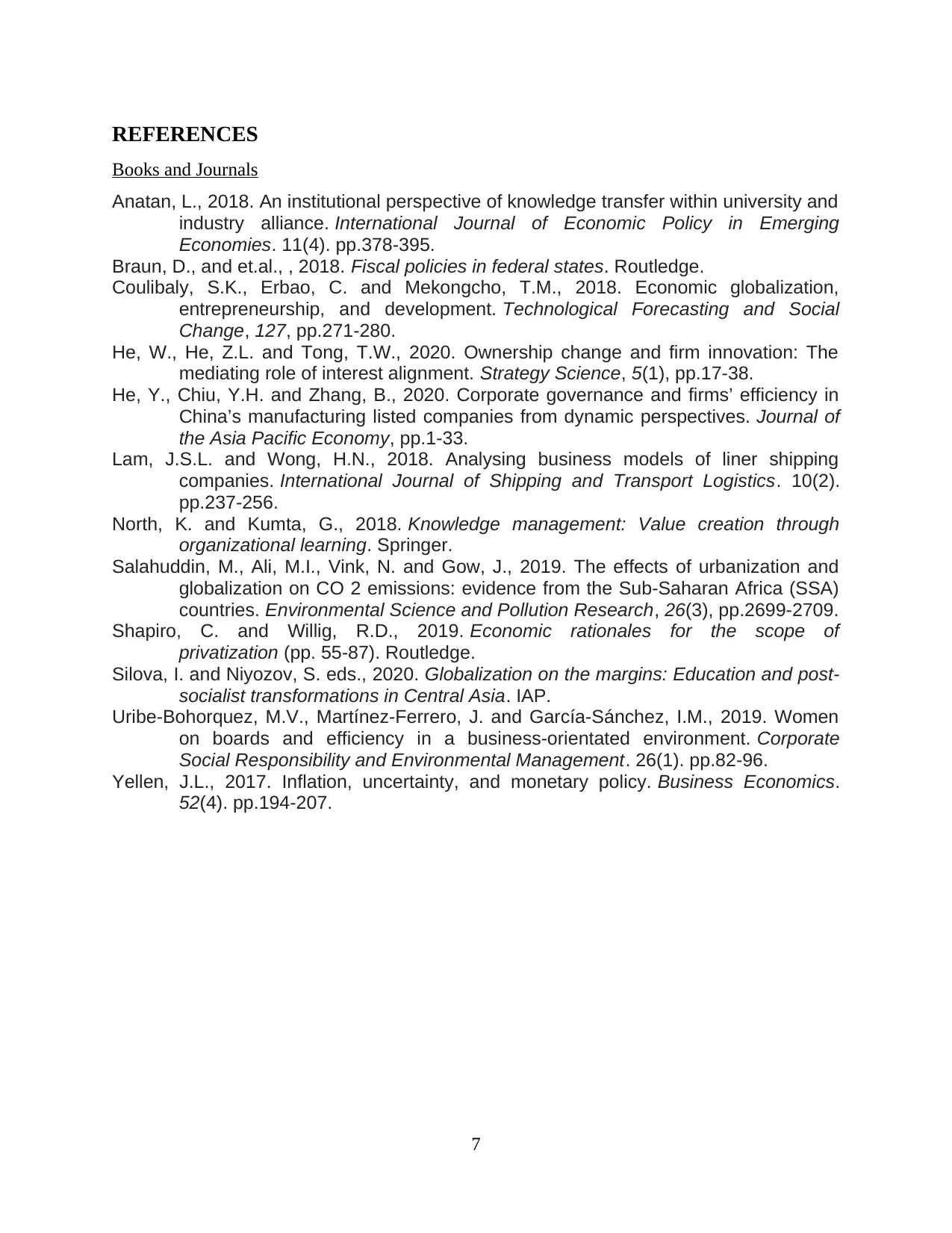
REFERENCES
Books and Journals
Anatan, L., 2018. An institutional perspective of knowledge transfer within university and
industry alliance. International Journal of Economic Policy in Emerging
Economies. 11(4). pp.378-395.
Braun, D., and et.al., , 2018. Fiscal policies in federal states. Routledge.
Coulibaly, S.K., Erbao, C. and Mekongcho, T.M., 2018. Economic globalization,
entrepreneurship, and development. Technological Forecasting and Social
Change, 127, pp.271-280.
He, W., He, Z.L. and Tong, T.W., 2020. Ownership change and firm innovation: The
mediating role of interest alignment. Strategy Science, 5(1), pp.17-38.
He, Y., Chiu, Y.H. and Zhang, B., 2020. Corporate governance and firms’ efficiency in
China’s manufacturing listed companies from dynamic perspectives. Journal of
the Asia Pacific Economy, pp.1-33.
Lam, J.S.L. and Wong, H.N., 2018. Analysing business models of liner shipping
companies. International Journal of Shipping and Transport Logistics. 10(2).
pp.237-256.
North, K. and Kumta, G., 2018. Knowledge management: Value creation through
organizational learning. Springer.
Salahuddin, M., Ali, M.I., Vink, N. and Gow, J., 2019. The effects of urbanization and
globalization on CO 2 emissions: evidence from the Sub-Saharan Africa (SSA)
countries. Environmental Science and Pollution Research, 26(3), pp.2699-2709.
Shapiro, C. and Willig, R.D., 2019. Economic rationales for the scope of
privatization (pp. 55-87). Routledge.
Silova, I. and Niyozov, S. eds., 2020. Globalization on the margins: Education and post-
socialist transformations in Central Asia. IAP.
Uribe‐Bohorquez, M.V., Martínez‐Ferrero, J. and García‐Sánchez, I.M., 2019. Women
on boards and efficiency in a business‐orientated environment. Corporate
Social Responsibility and Environmental Management. 26(1). pp.82-96.
Yellen, J.L., 2017. Inflation, uncertainty, and monetary policy. Business Economics.
52(4). pp.194-207.
7
Books and Journals
Anatan, L., 2018. An institutional perspective of knowledge transfer within university and
industry alliance. International Journal of Economic Policy in Emerging
Economies. 11(4). pp.378-395.
Braun, D., and et.al., , 2018. Fiscal policies in federal states. Routledge.
Coulibaly, S.K., Erbao, C. and Mekongcho, T.M., 2018. Economic globalization,
entrepreneurship, and development. Technological Forecasting and Social
Change, 127, pp.271-280.
He, W., He, Z.L. and Tong, T.W., 2020. Ownership change and firm innovation: The
mediating role of interest alignment. Strategy Science, 5(1), pp.17-38.
He, Y., Chiu, Y.H. and Zhang, B., 2020. Corporate governance and firms’ efficiency in
China’s manufacturing listed companies from dynamic perspectives. Journal of
the Asia Pacific Economy, pp.1-33.
Lam, J.S.L. and Wong, H.N., 2018. Analysing business models of liner shipping
companies. International Journal of Shipping and Transport Logistics. 10(2).
pp.237-256.
North, K. and Kumta, G., 2018. Knowledge management: Value creation through
organizational learning. Springer.
Salahuddin, M., Ali, M.I., Vink, N. and Gow, J., 2019. The effects of urbanization and
globalization on CO 2 emissions: evidence from the Sub-Saharan Africa (SSA)
countries. Environmental Science and Pollution Research, 26(3), pp.2699-2709.
Shapiro, C. and Willig, R.D., 2019. Economic rationales for the scope of
privatization (pp. 55-87). Routledge.
Silova, I. and Niyozov, S. eds., 2020. Globalization on the margins: Education and post-
socialist transformations in Central Asia. IAP.
Uribe‐Bohorquez, M.V., Martínez‐Ferrero, J. and García‐Sánchez, I.M., 2019. Women
on boards and efficiency in a business‐orientated environment. Corporate
Social Responsibility and Environmental Management. 26(1). pp.82-96.
Yellen, J.L., 2017. Inflation, uncertainty, and monetary policy. Business Economics.
52(4). pp.194-207.
7
⊘ This is a preview!⊘
Do you want full access?
Subscribe today to unlock all pages.

Trusted by 1+ million students worldwide
1 out of 9
Related Documents
Your All-in-One AI-Powered Toolkit for Academic Success.
+13062052269
info@desklib.com
Available 24*7 on WhatsApp / Email
![[object Object]](/_next/static/media/star-bottom.7253800d.svg)
Unlock your academic potential
Copyright © 2020–2025 A2Z Services. All Rights Reserved. Developed and managed by ZUCOL.



